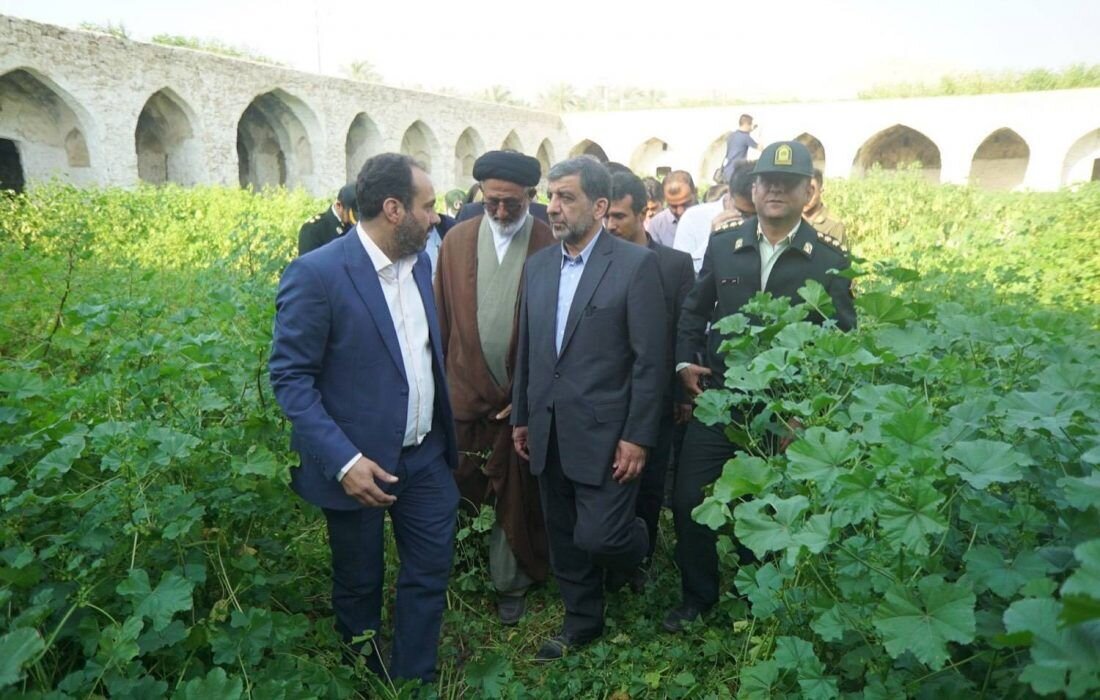Dalaki caravanserai needs to be revived, minister says

TEHRAN –Qajar-era Dalaki caravanserai in Dashtestan county, southwestern Bushehr province needs to be revived and restored, Cultural Heritage, Tourism, and Handicrafts Minister has said.
The historical inn needs to be prepared for the public visit, Ezzatollah Zarghami said on Thursday while visiting the county.
The caravanserai could turn into a handicrafts market after being fully restored, he added.
With over 6,000 years of history and significant monuments from the Elamite, Achaemenid, Parthian, and Sassanid eras, Bushehr Province is one of Iran’s most important historical centers.
Besides its cultural heritage, beautiful beaches and lush palm groves make it an attractive destination for world travelers.
The historical and architectural monuments of Bushehr include Islamic buildings like mosques and praying centers, mansions, old towers, castles, as well as gardens.
When it comes to cultural attractions, there are many historical mounds in Bushehr including Tall-e Khandaq with Sassanid architectural style, Tall-e Marv located near an Achaemenid Palace, and Qajar era Malek al-Tojar Mansion. Qajar era Kazeruni Mansion, which has been inscribed on the World Heritage List, is another attraction that world travelers love to see among various ancient sites.
Possible UNESCO tag for Iranian caravanserais
Iran has put forward a selection of 56 caravansaries as a candidate for collective inclusion on UNESCO’S cultural heritage list.
Last year, the tourism ministry announced that Iran was developing a dossier for a selection of its historical caravanserais for a possible inscription on the UNESCO World Heritage list. In this regard, cultural heritage experts are assessing such monuments that are scattered across the country to make a shortlist in terms of their architecture as well as historical and cultural values.
Caravansary (also Caravanserai or Caravansaray) is a building that served as the inn of the Orient, providing accommodation for commercial, pilgrim, postal, and especially official travelers.
According to Encyclopedia Iranica, from the number of surviving caravansaries and their sizes, it is clear that in Safavid and Qajar times there was a state architectural department that was specifically concerned with the construction of caravansaries and stations on the overland routes. Furthermore, in the cities, several caravansaries were erected as lodging houses, depots, and commercial offices in the vicinity of the bazaars.
A typical caravansary consists of a square or rectangular plan centered around a courtyard with only one entrance and arrangements for defense if necessary. Whether fortified or not, it at least provided security against beasts of prey and attacks by brigands.
The earliest caravanserais in Iran were built during the Achaemenid era (550 - 330 BC). Centuries later, when Shah Abbas I assumed power from 1588–to 1629, he ordered the construction of a network of caravanserais across the country.
For many travelers, staying in or even visiting a centuries-old caravanserai can be a wide experience; they have an opportunity to feel the past, a time travel back to a forgotten age.
Such roadside inns were once constructed along ancient caravan routes in the Muslim world to shelter people, their goods, and animals. The former Silk Roads may be the most famous example dotted by caravanserais.
Cozy chambers that are meticulously laid out around a vast courtyard may easily evoke spirits of the past. It’s not hard to fancy the hustle and bustle of merchants bargaining on prices, recounting their arduous journeys to one another while their camels chewing hay! You can also conceive the idea of local architectural style and material in its heyday.
It is not hard to fancy the hustle and bustle of merchants bargaining on prices, recounting their arduous journeys to one another while their camels chewing hay!
Passing major roads in the country, one may see crumbling caravanserais, many of which were abandoned for ages. In the Information Age, such guest houses have largely lost their actual usage.
However, a couple of years ago, the Iran tourism ministry introduced a scheme to keep them alive and profitable; tens of caravanserais are ceded to private investors for better maintenance. Now, some are exclusively renovated and repurposed into boutique hotels and tourist lodgings.
They often had massive portals supported by elevated load-bearing walls. Guest rooms were constructed around the courtyard and stables behind them with doors in the corners of the yard.
ABU/
Leave a Comment